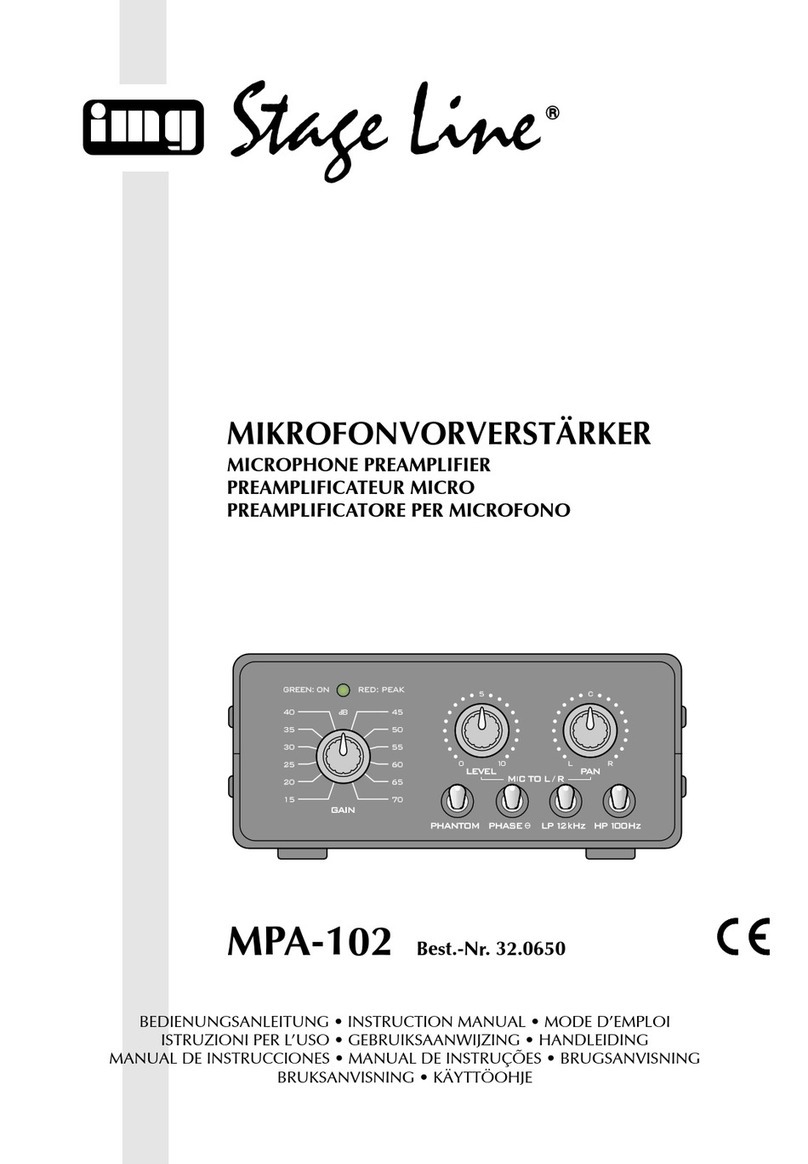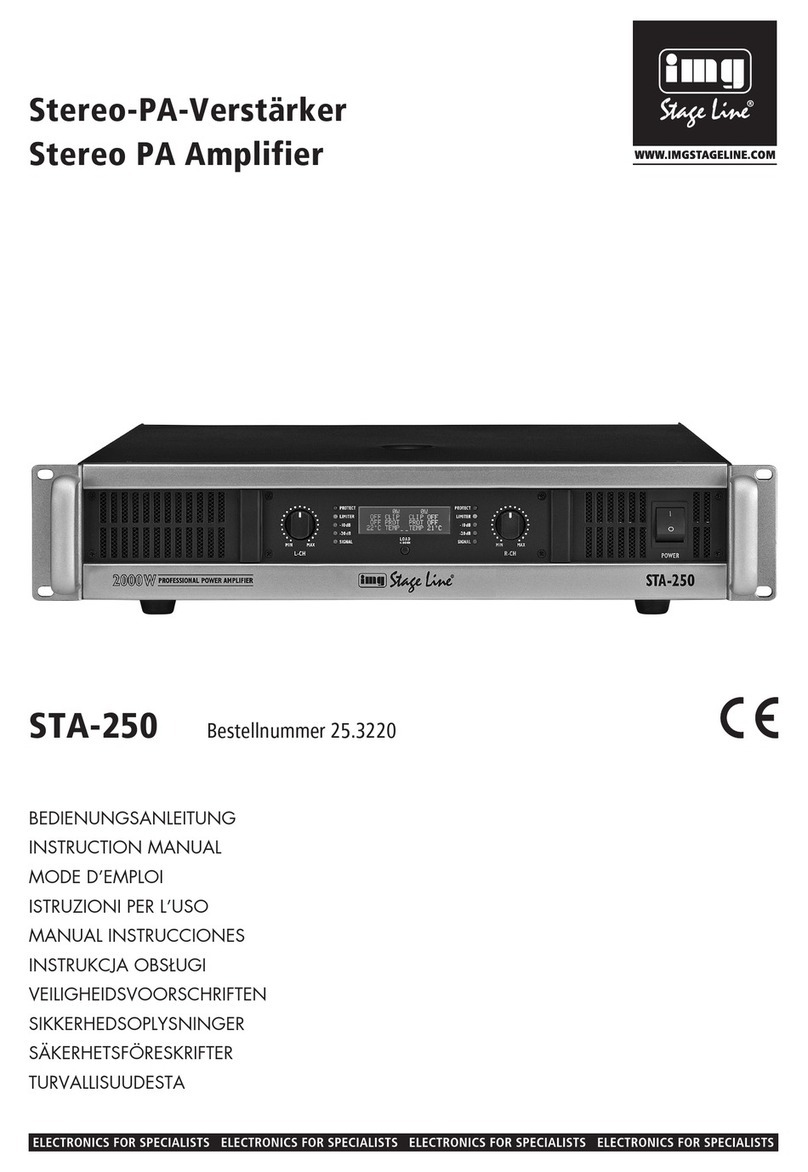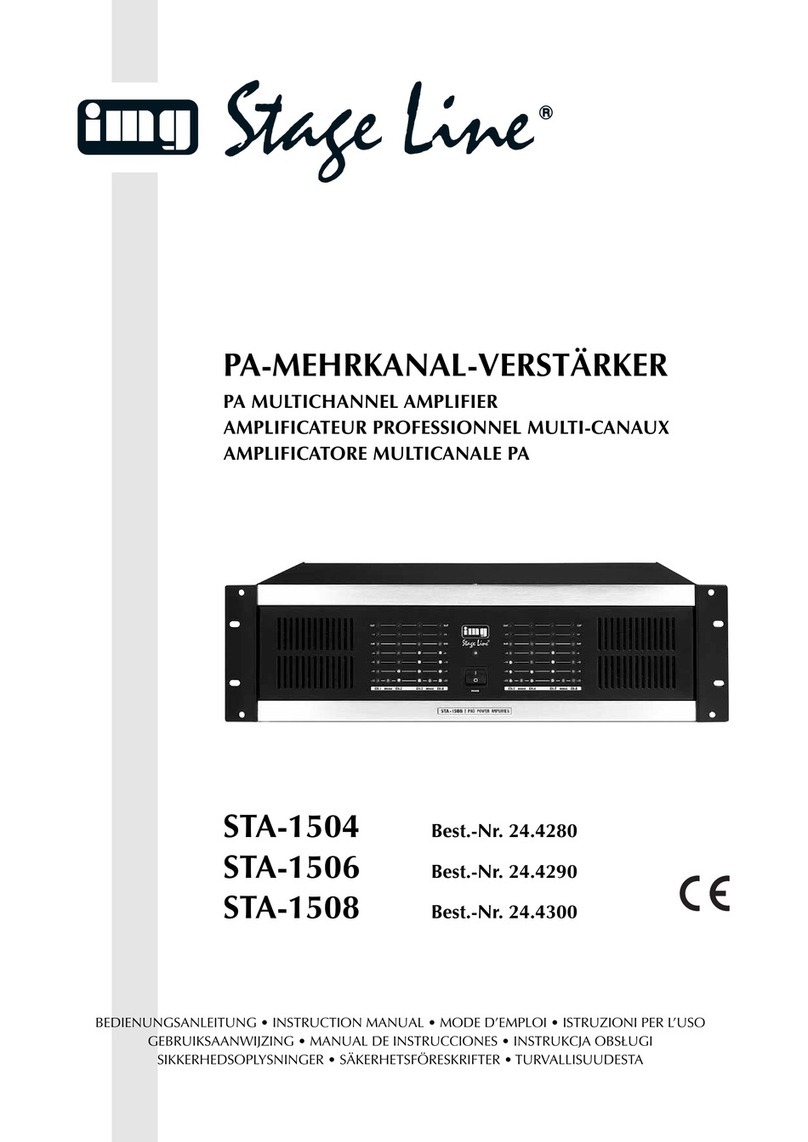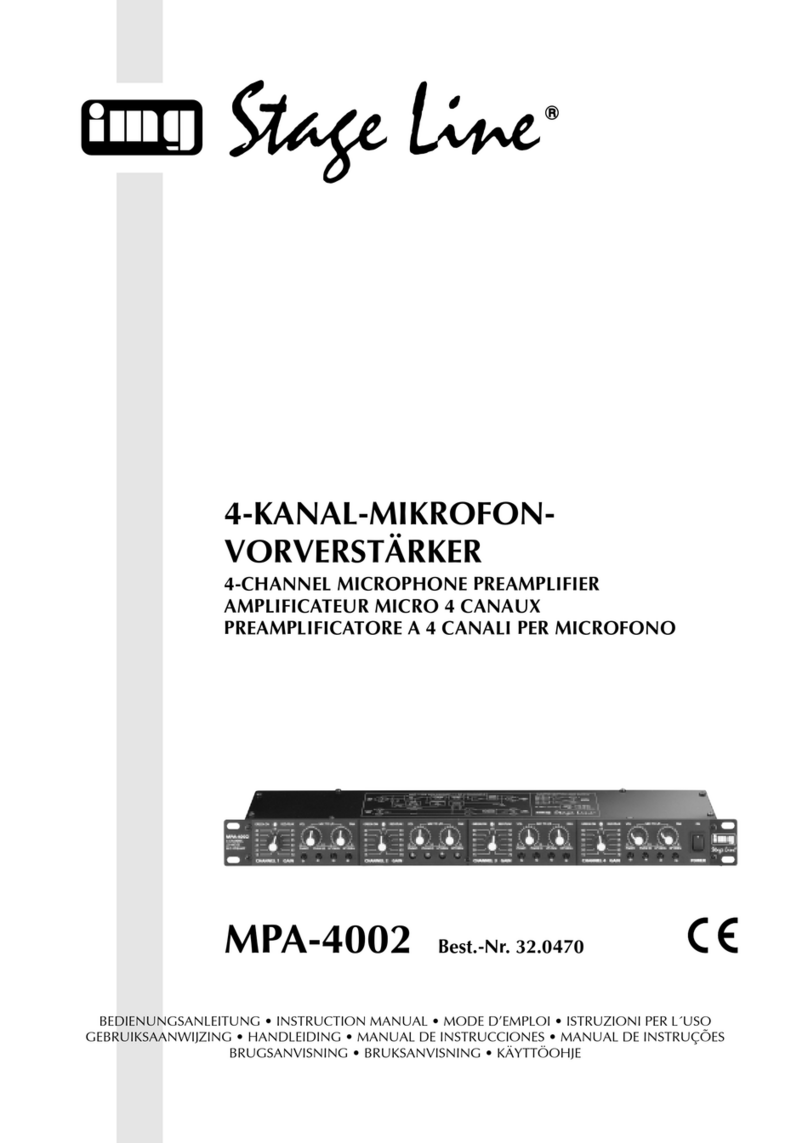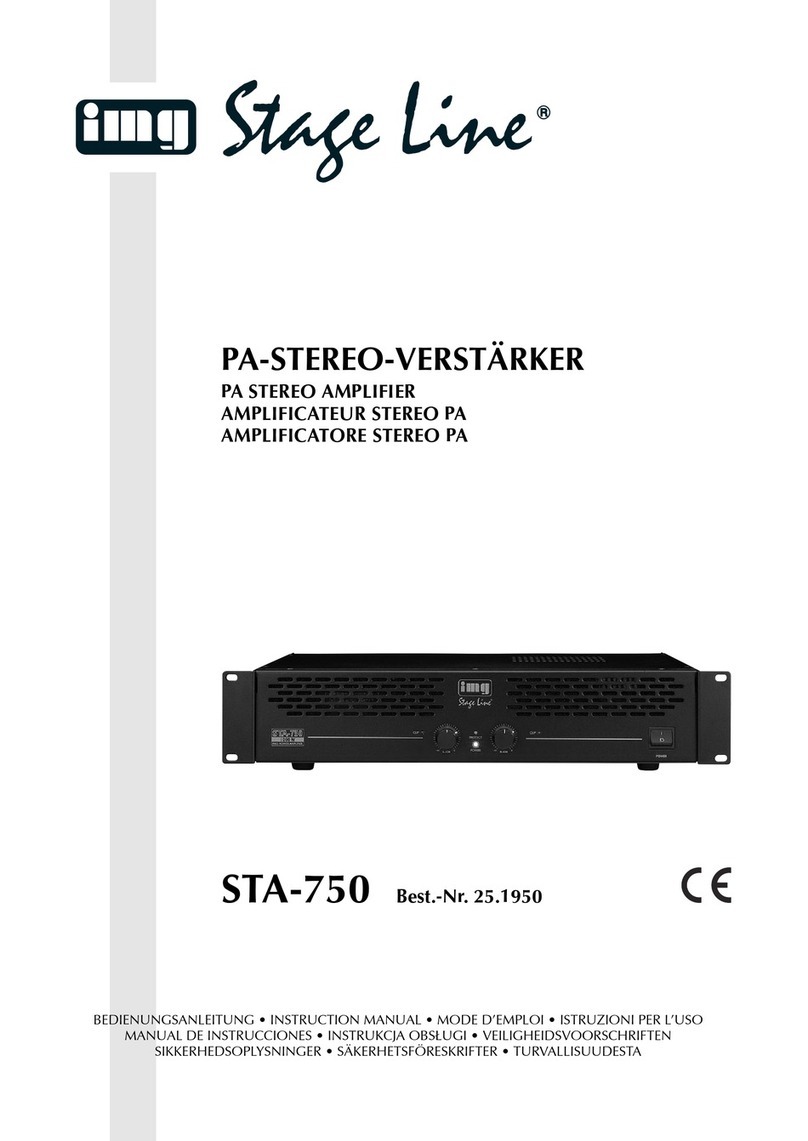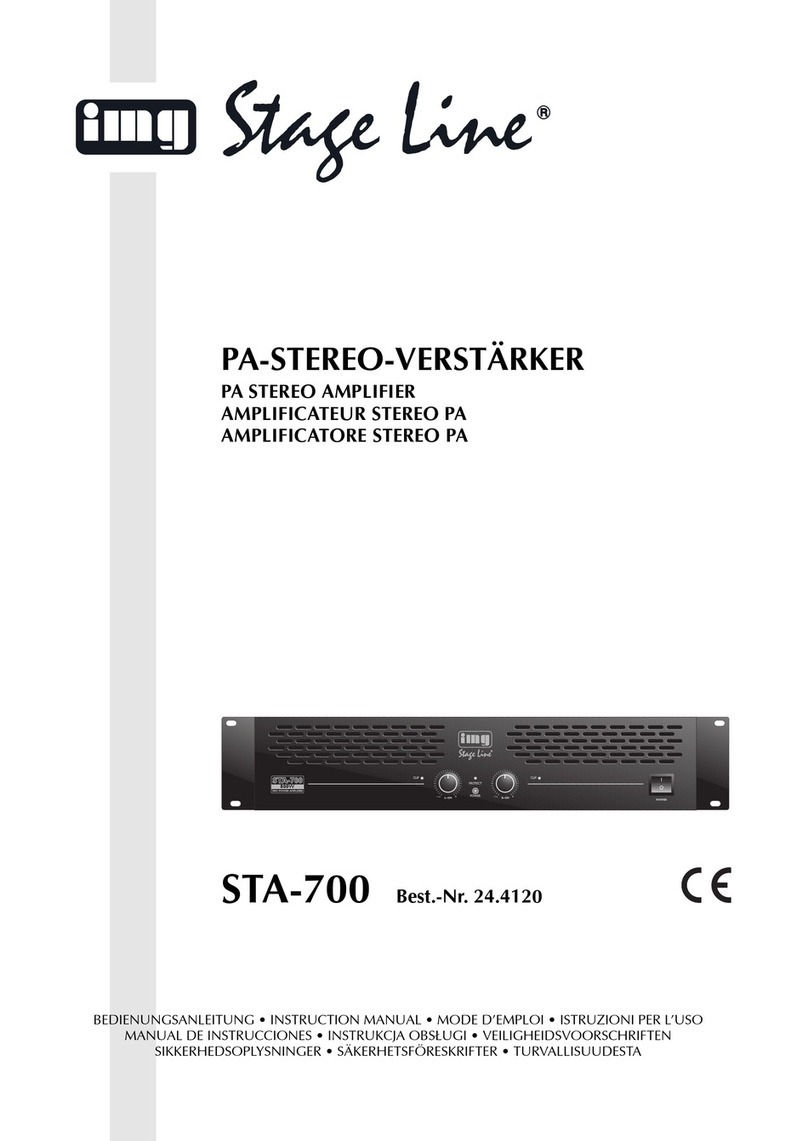●Nous déclinons toute responsabilité en cas de
dommages corporels ou matériels résultants si le
module est utilisé dans un but autre que celui pour
lequel il a été conçu, s’il n’est pas correctement
monté, branché, utilisé ou n’est pas réparé par
une personne habilitée, de même, la garantie
deviendrait caduque.
●Lorsque le module est définitivement retiré du ser-
vice, vous devez le déposer dans une usine de
recyclage adaptée pour contribuer à son élimina-
tion non polluante.
3 Possibilités d’utilisation
Le module amplificateur PAS-300 est conçu pour
être placé dans une enceinte 8Ω. Il se compose de
deux éléments distincts, montables séparément : un
préampli et un étage final 300W avec alimentation.
Le module amplificateur dispose d’un filtre
passe-haut Low Cut réglable, d’un égaliseur 3 voies
avec interrupteur Bypass et d’entrées micro et Ligne
symétriques, réglables séparément. Il est égale-
ment possible de relier, via la sortie pour repiquage,
une autre enceinte active.
4 Installation dans l’enceinte
●Avant ou pendant l’installation, l’étage final ne doit
en aucun cas être relié au secteur !
●Le haut-parleur relié doit avoir une impédance de
8Ωminimum. Dans le cas de plusieurs haut-par-
leurs, l’impédance totale du système haut-parleur
ne doit pas être inférieure à 8Ω.
Le haut-parleur ou le système de haut-parleurs
doit recevoir une puissance rms de 300W mini-
mum.
1) Le préampli doit être au-dessus de l’étage final.
La distance entre les deux éléments doit être de
200mm au plus :
pour placer le préampli dans l’enceinte, dé-
coupez un emplacement de 207 x 107mm. La
profondeur de montage nécessaire est de 50mm.
En dessous, pour placer l’étage final, décou-
pez un emplacement de 160 x 274mm. La pro-
fondeur de montage nécessaire est de 160mm.
2) Reliez les câbles haut-parleurs via des fiches
plates aux contacts OUT et GND (23) sur le cir-
cuit de l’étage final. Veillez à respecter la polarité,
c’est-à-dire à relier le conducteur repéré (pôle
plus) du haut-parleur au contact OUT.
3) Fixez l’étage final avec 10 vis sur l’enceinte.
4) Reliez le câble 6 pôles (22) venant de l’étage
final à la prise 6 pôles CON5 sur la platine du
préampli.
5) Fixez le préampli avec 8 vis à l’enceinte.
5 Branchements des appareils
1) Reliez les appareils audio soit via une fiche XLR
ou une fiche Jack 6,35 aux prises d’entrée sy-
métriques respectives :
prise MIC IN (10) :
pour brancher un micro ou un récepteur de
micro sans fil
prise LINE IN (11) :
pour relier un appareil à sortie niveau ligne
(par exemple instrument, table de mixage)
2) Sur la sortie XLR symétrique PARALLEL OUT
(12), le signal d’entrée repiqué de la prise LINE IN
est disponible. On peut relier ici par exemple l’en-
trée Ligne d’une autre enceinte active.
3) Uniquement une fois que les deux composants
sont placés dans l’enceinte et que le branche-
ment des appareils audio est effectué, vous pou-
vez relier le cordon secteur livré à la prise secteur
(17). Reliez ensuite le cordon à une prise 230V~/
50Hz.
6 Fonctionnement
Avant d’allumer le module, il est recommandé de
mettre le potentiomètre LEVEL (16) sur la position
“0” pour éviter tout bruit fort à l’allumage.
1) Allumez les sources de signal reliées.
2) Allumez l’enceinte active avec l’interrupteur
POWER (20). La LED POWER verte (13), témoin
de fonctionnement brille.
3) Tournez le potentiomètre LEVEL (16) pour le
volume général jusqu’à ce que le rapport de
mixage des canaux d’entrée soit réglé de
manière optimale. Avec les potentiomètres GAIN
(2, 3), mixez les canaux d’entrée. Si un canal
n’est pas utilisé, son potentiomètre de niveau doit
rester sur “0”.
Si le niveau de sortie de la source de signal
est trop faible sur le canal micro MIC, il est possi-
ble d’augmenter la plage de réglage pour l’ampli-
fication en enfonçant le commutateur (1).
4) Ensuite, avec le potentiomètre LEVEL, réglez
le volume définitif souhaité. En cas de surcharge
de l’étage final, la LED CLIP (14) jaune brille :
tournez alors le potentiomètre LEVEL et/ou les
potentiomètres GAIN dans l’autre sens, en fonc-
tion.
5) Avec l’égaliseur, vous pouvez régler l’image
sonore ; pour ce faire, enfoncez la touche EQ
ON/OFF (5) : la LED EQ ON (9) verte brille, l’é-
galiseur est allumé. En désactivant la touche, l’é-
galiseur, peut, si besoin, être bridgé (décon-
necté).
Avec les égaliseurs (6, 7, 8), réglez l’image
sonore souhaitée : il est possible de régler les
graves (potentiomètre LOW), les médiums (po-
tentiomètre MID) et les aigus (potentiomètre
HIGH) de ±12dB. Si les potentiomètres sont sur
la position médiane, il n’y a pas de modification
de tonalité.
●Nel caso d’uso improprio, di montaggio scorretto,
di collegamenti sbagliati, di impiego sbagliato o di
riparazione non a regola d’arte non si assume
nessuna responsabilità per eventuali danni a per-
sone o a cose.
●Se si desidera eliminare il modulo definitivamente,
consegnarlo per lo smaltimento ad un’istituzione
locale per il riciclaggio.
3 Possibilità d’impiego
Il modulo amplificatore PAS-300 è stato realizzato
per il montaggio in una cassa acustica di 8Ω. È
composto da due componenti da montare separata-
mente: uno stadio d’ingresso e uno stadio finale di
300W con alimentatore.
Il modulo amplificatore è equipaggiato con un fil-
tro low-cut regolabile, con una regolazione toni con
3 frequenze diverse con commutatore bypass e con
ingressi simmetrici per microfono e Line, regolabili
separatamente. Per mezzo dell’uscita di attraversa-
mento è possibile collegare un’altra cassa acustica
attiva.
4 Montaggio nella cassa acustica
●In nessun caso, lo stadio finale deve essere colle-
gato con la tensione di rete prima del montaggio o
durante il montaggio!
●Un altoparlante collegato deve avere un’impe-
denza di 8Ωmin. Nel caso di più altoparlanti, l’im-
pedenza globale del sistema di altoparlanti non
deve essere inferiore a 8Ω.
L’altoparlante o il sistema di altoparlanti deve
avere una potenza efficace di 300W min.
1) Lo stadio d’ingresso deve essere disposto al di
sopra dello stadio finale. La distanza fra i due
stadi non deve superare i 200mm:
Per il montaggio dello stadio d’ingresso nella
cassa acustica tagliare un’apertura di 207 x
107mm. La profondità di montaggio necessaria è
di 50mm.
Sotto questa apertura preparane un’altra di
160 x 274mm. La profondità di montaggio neces-
saria per lo stadio finale è di 160mm.
2) Collegare i cavi per gli altoparlanti con i contatti
OUT e GND (23) sulla scheda dello stadio finale,
rispettando la corretta polarità: collegare il filo
marcato (positivo) dell’altoparlante con il contatto
OUT.
3) Fissare lo stadio finale sulla cassa con l’aiuto di
10 viti.
4) Inserire il cavetto a 6 poli (22) proveniente dallo
stadio finale nel connettore maschio CON5 sulla
scheda dello stadio d’ingresso.
5) Fissare lo stadio d’ingresso sulla cassa con l’aiu-
to di 8 viti.
5 Collegamento degli apparecchi
1) Collegare gli apparecchi audio con un connettore
XLR o un jack 6,3mm con le relative prese sim-
metriche d’ingresso:
Presa MIC IN (10):
per il collegamento di un microfono o del rice-
vitore di un radiomicrofono
Presa LINE IN (11):
per il collegamento di un apparecchio con
uscita Line (p.es. strumento musicale, mixer)
2) All’uscita simmetrica XLR PARALLELOUT (12) è
disponibile il segnale dell’ingresso Line della
presa LINE IN. Qui si può collegare p.es. l’in-
gresso Line di un’altra cassa acustica attiva.
3) Solo dopo aver montato nella cassa lo stadio
d’ingresso e quello finale e dopo aver collegato
gli apparecchi audio, inserire il cavo rete in dota-
zione nella presa (17) del modulo e in una presa
di rete (230V~/50Hz).
6 Funzionamento
Prima dell’accensione conviene portare il regolatore
LEVEL (16) in posizione “0” per escludere eventuali
rumori di commutazione.
1) Accendere le sorgenti collegate.
2) Accendere la cassa attiva con l’interruttore on/off
POWER (20). Si accende il LED verde di funzio-
namento POWER (13).
3) Aprire il regolatore LEVEL (16) per il volume glo-
bale fino al punto da poter impostare in modo
ottimale il rapporto di miscelazione fra i canali
d’ingresso. Miscelare i canali d’ingresso con i
regolatori GAIN (2, 3). Se un canale non viene
utilizzato, mettere il suo regolatore sullo “0”.
Se il livello d’uscita della sorgente sul canale
MIC è troppo basso, il campo di regolazione
dell’amplificazione può essere aumentato pre-
mendo il tasto di commutazione (1).
4) Successivamente impostare il volume definitivo
con il regolatore LEVEL. Nel caso di sovrapilo-
taggio dello stadio finale si accende il LED giallo
CLIP (14) – allora abbassare i regolatori LEVEL
e/o GAIN.
5) Con l’equalizzatore si possono impostare i toni.
Per fare ciò premere il pulsante EQ ON/OFF (5);
il LED verde EQ ON (9) si accende e la regola-
zione dei toni è attivata. Sbloccando il pulsante,
la regolazione dei toni può essere bypassata
(disattivata) se necessario.
Impostare i toni con i regolatori (6, 7, 8): i bassi
(regolatore LOW), i medi (regolatore MID) e gli
alti (regolatore HIGH) possono essere modificati
fino a ±12dB. In posizione centrale, i toni ri-
mangono non modificati.
6) Con il regolatore FREQUENCY (4) si può im-
postare la frequenza di taglio inferiore per il filtro
low-cut (passaalto) fra 20Hz e 120 Hz. I disturbi a
bassa frequenza al di sotto della frequenza di
taglio impostata (p.es. passi) vengono sop-
pressi. Più si apre il regolatore in senso orario,
più si posta in alto la frequenza di taglio.
8
I
F
B
CH

